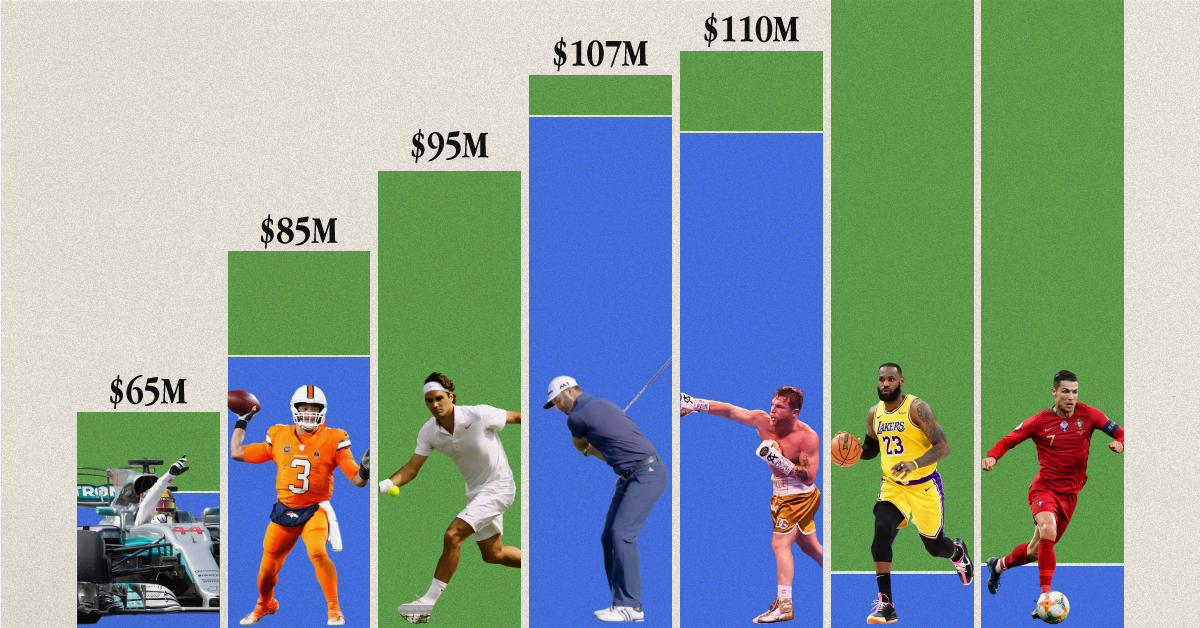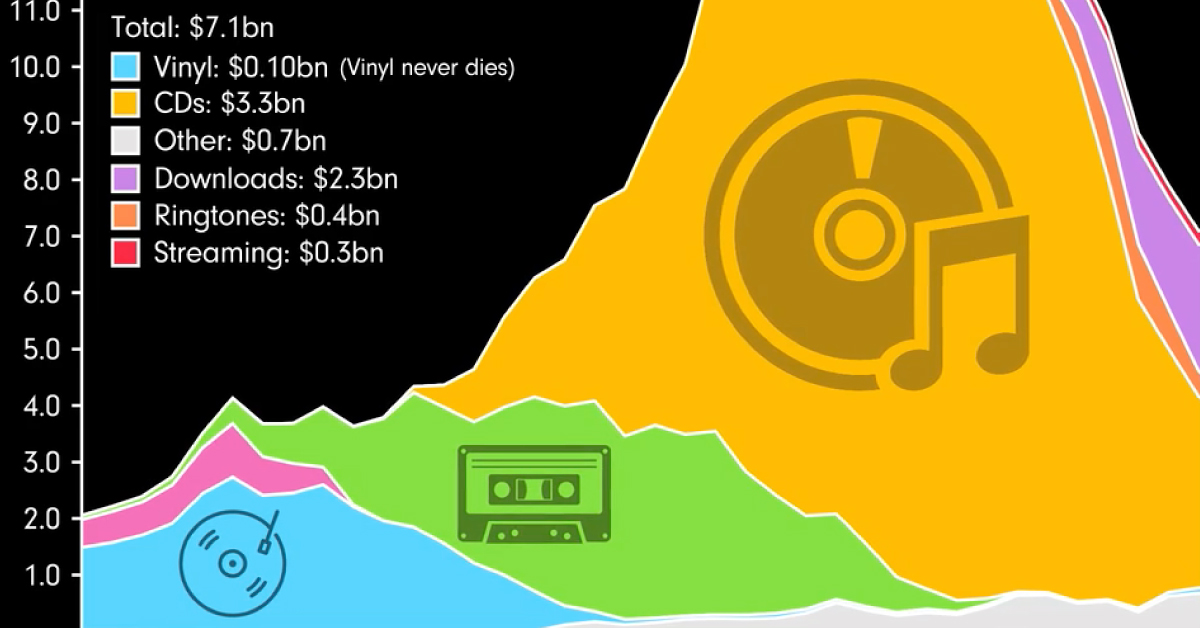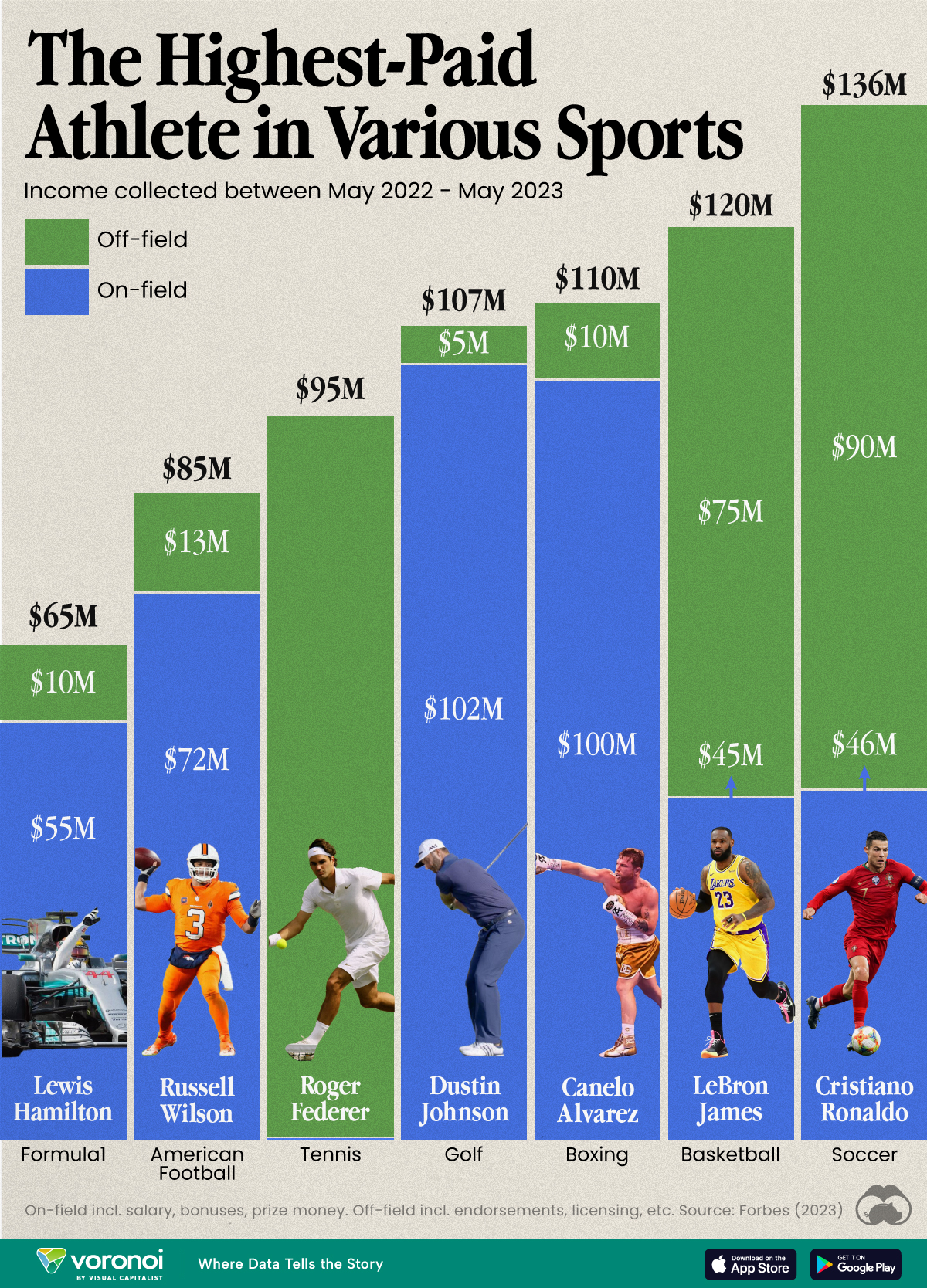Culture
Animated Chart: The Rise and Fall of Music Sales, by Format (1973-2021)
The Rise and Fall of Music Sales, by Format (1973-2021)
We live in a world of music. Whether when driving to work or jamming out at home, people around the world like to have their favorite tunes playing in the background.
But while our love for music has been constant, the way we consume media has evolved drastically. The past 50 years have seen many different music formats used to access these tunes, mirroring society’s shift from analog to digital.
This video, created by James Eagle using data from the Recording Industry Association of America (RIAA), highlights sales of different music formats in the U.S. over the last 50 years.
Vinyl
Up until the late 1980s, vinyl dominated the music format industry, earning billions of dollars in sales annually. Records of Bruce Springsteen’s Born to Run or Pink Floyd’s Dark Side of the Moon were some of the top selling albums available.
Vinyl is said to provide its listeners with analog sounds that reverberate and the warm notes of almost-live music. For vinyl users and enthusiasts to this day, the music produced by these sleek yet massive records is unparalleled.
8-Track
If you’re a millennial (or younger), you may have never heard of the 8-track. But this music format played an integral part in the history of music.
When the booming automotive vehicle industry found it challenging to translate the music experience to cars using vinyl, it looked to the “Stereo 8” eight-track cartridge, better known as the 8-track. This cartridge used an analog magnetic tape and provided 90 minutes of continuous music play time.
8-track carved a niche for itself much before the advent of cassettes and CDs. And through the proliferation of vehicles, 8-track sales climbed to reach a peak revenue of $900 million in 1978.
Cassettes
The era of cassettes pushed 8-tracks into the history of music in the early 1980s. These pocket-sized tapes were more convenient to use than 8Tracks and quickly spread worldwide.
By 1989, the cassette format reached its peak revenues of $3.7 billion.
CDs
First released in 1982, the Compact Disc or CD came into the music market as the successor to the vinyl record.
Developed by Philips and Sony, sales of the sleek and portable CD grew quickly as home and car stereos alike added CD functionality. The format brought in $13.3 billion in revenue in both 1999 and 2000. To date, no other music format has reached the same milestone since.
Digital Music Formats
When it comes to preferred music formats over time, convenience (and cost) seem to have been the biggest catalysts of change.
From the start of the early 2000s, CDs had started to be replaced by other forms of digital storage and distribution. The massive shift to internet consumption and the introduction of digital music, available through downloads, pushed audio CD sales down rapidly.
The launch of streaming platforms like Spotify in 2006 exacerbated this decline, with CD sales dropping by around $4 billion in five years.
Digital sales continued to evolve. Ringtone sales alone brought in $1.1 billion in 2007, and in 2012, the revenues from downloads shot up to a peak of $2.9 billion. But music streaming platforms kept climbing through 2021, and will likely continue to be the future face of music consumption.
| Rank | Music formats | Revenue in 2021 |
|---|---|---|
| 1 | Streaming | $11.5 billion |
| 2 | Vinyl | $1.0 billion |
| 3 | CD | $0.6 billion |
| 4 | Downloads | $0.5 billion |
| Other | $1.4 billion | |
| Total | $15.1 billion |
Music streaming and subscription services pushed the accessibility of music to new highs, especially with free ad-supported platforms.
In 2021, streaming secured the music industry a whopping $11.5 billion in sales, good for 76% of the total. If it keeps growing in popularity and accessibility, the format could potentially challenge the peak popularity of CDs in the late 90s.
The Vintage Comeback?
There’s no doubt that digital music formats are getting increasingly popular with every passing year. However, one of our vintage and beloved music formats—the vinyl record—seems to be making a comeback.
According to the RIAA database, the revenue earned by LP/EP sales has shot up to $1.0 billion in 2021, its highest total since the mid-1980s.

This article was published as a part of Visual Capitalist's Creator Program, which features data-driven visuals from some of our favorite Creators around the world.
Culture
The Highest Earning Athletes in Seven Professional Sports
We illustrate how much the highest earning athletes across seven different sports make, and where they get their money from.

The Highest Earning Athletes in Seven Professional Sports
This was originally posted on our Voronoi app. Download the app for free on Apple or Android and discover incredible data-driven charts from a variety of trusted sources.
How much money do the world’s biggest athletes really make? And how do they compare across different sports?
We visualized the highest earning athletes in various professional sports, according to calculations from Forbes. Earnings reported here cover the period of May 2022 to May 2023. Earnings includes on-field (salary, bonuses, prize money) and off-field (endorsements, licensing, etc).
Forbes’ research included talking to industry insiders, following news reports, and parsing salary databases. Please see their methodology page for further details.
Who is the Highest Paid Athlete in the World?
Cristiano Ronaldo was the highest-paid athlete in the world, making an estimated $136 million between May 2022 and May 2023. His move to Saudi Arabian club Al Nassr set a record for the biggest contract in the sport at the time.
Here’s how he compared to the top earners in some other sports.
| Athlete | Sport | Total Earnings (May 2022–23) |
|---|---|---|
| Cristiano Ronaldo | ⚽ Soccer | $136M |
| LeBron James | 🏀 Basketball | $120M |
| Canelo Alvarez | 🥊 Boxing | $110M |
| Dustin Johnson | ⛳ Golf | $107M |
| Roger Federer | 🎾 Tennis | $95M |
| Russell Wilson | 🏈 American Football | $85M |
| Lewis Hamilton | 🏎️ Formula 1 | $65M |
Note: Figures are rounded.
Los Angeles Lakers superstar LeBron James made the most money in basketball (just under $120 million), which is almost twice as much as Formula 1’s top earner, Lewis Hamilton, who took home about $65 million in 2022–23.
Something else to note is how off-court earnings can contribute significantly to total income for some athletes.
| Athlete | Sport | On-Field Earnings | Off-Field Earnings |
|---|---|---|---|
| Cristiano Ronaldo | ⚽ Soccer | $46M | $90M |
| LeBron James | 🏀 Basketball | $45M | $75M |
| Canelo Alvarez | 🥊 Boxing | $100M | $10M |
| Dustin Johnson | ⛳ Golf | $102M | $5M |
| Roger Federer | 🎾 Tennis | $0.1M | $95M |
| Russell Wilson | 🏈 American Football | $72M | $13M |
| Lewis Hamilton | 🏎️ Formula 1 | $55M | $10M |
Note: Figures are rounded.
This is most apparent with Roger Federer, who retired in 2022, after playing his last Laver Cup. However, his massive deals with Uniqlo, Rolex, and Mercedes, as well as his stake in running company On, still keeps him towards the top of the these lists.
Together with Ronaldo and James, these three athletes are widely considered the face of their sport, undoubtedly helping them secure lucrative endorsements and business deals.
-

 Markets2 weeks ago
Markets2 weeks agoVisualizing America’s Shortage of Affordable Homes
-

 Technology1 week ago
Technology1 week agoRanked: Semiconductor Companies by Industry Revenue Share
-

 Money2 weeks ago
Money2 weeks agoWhich States Have the Highest Minimum Wage in America?
-

 Real Estate2 weeks ago
Real Estate2 weeks agoRanked: The Most Valuable Housing Markets in America
-

 Business2 weeks ago
Business2 weeks agoCharted: Big Four Market Share by S&P 500 Audits
-

 AI2 weeks ago
AI2 weeks agoThe Stock Performance of U.S. Chipmakers So Far in 2024
-

 Misc2 weeks ago
Misc2 weeks agoAlmost Every EV Stock is Down After Q1 2024
-

 Money2 weeks ago
Money2 weeks agoWhere Does One U.S. Tax Dollar Go?











